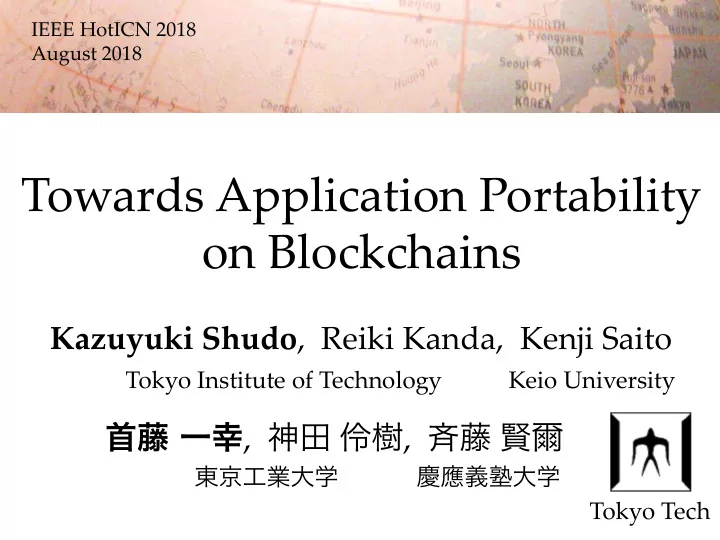

東京工業大学 慶應義塾大学 IEEE HotICN 2018 August 2018 Towards Application Portability on Blockchains Kazuyuki Shudo , Reiki Kanda, Kenji Saito Tokyo Institute of Technology Keio University 首藤 一幸 , 神田 伶樹 , 斉藤 賢爾 Tokyo Tech
About 9,500 nodes https://bitnodes.earn.com/ 1 / 10 Background: (Public) Blockchain • A distributed system supporting Today’s cryptocurrencies A peer-to-peer (P2P) network – Bitcoin’s market of participating capitalization is US$ 110B. nodes Node (miner) = An application-level – 9,500 Bitcoin nodes network A hash chain of blocks • A block and transactions Block Block in the block are Hash value Hash value confirmed by Proof of A crypto- graphic TX TX TX TX TX TX Work / Stakes / Importance / hash function Elapsed Time / … algorithms. – A winning node (miner) takes some new coins .
2 / 10 Problem: “Incentive mismatch” / インセンティブ ( 動機 ) 不整合 • Blockchain nodes and applications do not share common incentive. I want to utilize Blockchain blockchain applications features . ≠ I just want Nodes coins . • If a public blockchain cannot provide sufficient economic incentives … Part of icons made by Freepik from www.flaticon.com is licensed by CC 3.0 BY.
3 / 10 Problem: “Incentive mismatch” / インセンティブ ( 動機 ) 不整合 • If a public blockchain cannot provide sufficient economic incentives … I just want – E.g. A fall in coin prices coins . Node (miner) operator • It loses the ability to confirm transactions securely. – Fewer supporting nodes ‐ > Vulnerable to attacks • Majority (51%) attack, eclipse attack, … • In May 2018, such attacks succeeded in a row. – Bitcoin Gold: 388,200 BTG = US$ 18,600,000 = 20 億 JPY/ 円 – Monacoin: 23,832 MONA = US$ 93,500 = 1,000 万 JPY/ 円
4 / 10 Possible solutions I want to support applications. 1. Align their incentives ??? Node (miner) operator – … Non ‐ trivial and an open problem 2. Make applications portable Middleware design – A potential (and next ‐ best) solution •Our contributions Migration process – (Pointing out “incentive mismatch” problem) – A middleware design that enables application migration between blockchains – Migration process – Note: Implementation is part of future work.
5 / 10 Preparation: Portability levels (1) Runnable (2) Migratable An application can migrate. An application can run on both. Application A Application A Application A Application A Blockchain A Blockchain B Blockchain A Blockchain B • Runnable – A common API and smart contract language enable runnable portability. – Different blockchains running the same middleware also enable it. – It is unlikely to be useful because it requires application restart and loses fundamental blockchain features: • Proof of data existence • Verification of state changes • Migratable – our target
6 / 10 Preparation: Data to be migrated In case of a cryptocurrency: (1) Current state of the application ・ Account balance (2) Logs ・ Transactions – Metadata of the states that describe state changes and their time stamps. Fundamental blockchain features: ・ Proof of data existence does not require logs. ・ Verification of state changes requires logs.
7 / 10 Middleware design • Design principles – Minimize dependence on specific blockchain middleware • It stores simple data items, such as numbers or byte sequences, together with time stamps. – Do not expect to be able to retain trust in the original (source) blockchain • We cannot continue to rely on it in case of imminent collapse of it. (a) A blockchain stores data. (b) An external database stores data. Application Application Middleware Middleware enabling application migration enabling application migration - Index in the database - Data item - Hashed value of the data item - Data item - Time stamp - Time stamp Blockchain, Blockchain, Database that stores a pair of integers that stores a blob with a time stamp with a time stamp
8 / 10 Middleware design (cont’d) (a) A blockchain stores data. (b) An external database stores data. Application Application Middleware Middleware - Index in the database - Data item - Data item - Hashed value of the data item - Time stamp - Time stamp Blockchain Database Blockchain • Pros and cons – (b) reduces the blockchain size, Instead, the database should be fault ‐ tolerant. Replication or erasure coding work. • If verification of state (data) changes is – required: (a) must keep the original blockchains. In other words, (b) must keep all the versions of data. Logs are required. – not required: (a) can abandon the original blockchains after copying metadata to prove the data exist. (b) can overwrite data.
9 / 10 Migration process In case verification of state (data) changes is required The middleware • stores a static copy of the original blockchain, truncating it at the expiration time specified in block height . – Not rely on the original blockchain’s middleware to still be running and accessible online. – Truncating allows us to stop trusting the original blockchain after the expiration time. • makes a chain of the stored blockchains. It prevents tampering. • accesses the stored blockchain. It requires a parsing library.
10 / 10 Summary • “Incentive mismatch” problem pointed out • Middleware design enabling application migration presented • Migration process provided • Future work – Proof of the design by implementation – Incentive ‐ matched blockchain – Interoperability between heterogeneous blockchains Tokyo Tech
Recommend
More recommend